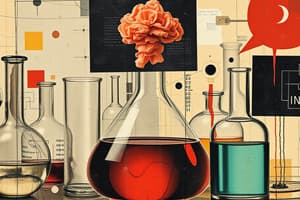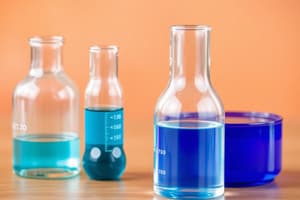Podcast
Questions and Answers
Which of the following is NOT a component of what chemistry deals with?
Which of the following is NOT a component of what chemistry deals with?
- The identification of the substances that make up matter
- The creation of new substances through chemical processes
- The investigation of the properties of matter
- The study of the composition of the Earth's atmosphere (correct)
Energy can be defined as a physical condition determined by molecular structure.
Energy can be defined as a physical condition determined by molecular structure.
False (B)
What is the fundamental definition of matter?
What is the fundamental definition of matter?
Matter is anything that has mass and occupies space.
Chemistry is the branch of science that deals with the ______ of the substances of which matter is composed.
Chemistry is the branch of science that deals with the ______ of the substances of which matter is composed.
Match the following terms with their corresponding definitions:
Match the following terms with their corresponding definitions:
Which of the following is NOT a physical property of matter?
Which of the following is NOT a physical property of matter?
The ability of a substance to be hammered into thin sheets without breaking is called ductility.
The ability of a substance to be hammered into thin sheets without breaking is called ductility.
What is the term for the temperature at which a liquid changes into a gas?
What is the term for the temperature at which a liquid changes into a gas?
The ability of a substance to dissolve in a solvent is known as ______.
The ability of a substance to dissolve in a solvent is known as ______.
Match the following physical properties with their descriptions:
Match the following physical properties with their descriptions:
Which of the following is a chemical property of matter?
Which of the following is a chemical property of matter?
The reaction of a substance with acids is considered a physical property.
The reaction of a substance with acids is considered a physical property.
What is the name of the process by which a liquid changes into a solid?
What is the name of the process by which a liquid changes into a solid?
Which of the following is an example of a homogenous mixture?
Which of the following is an example of a homogenous mixture?
Compounds are made up of two or more elements chemically combined in specific ratios.
Compounds are made up of two or more elements chemically combined in specific ratios.
What is the process of separating metals from compounds by melting them called?
What is the process of separating metals from compounds by melting them called?
A ______ is a mixture in which particles are dispersed throughout a fluid, but can be filtered out.
A ______ is a mixture in which particles are dispersed throughout a fluid, but can be filtered out.
Which of these is NOT a method of food preservation?
Which of these is NOT a method of food preservation?
Match the following terms with their best description:
Match the following terms with their best description:
Chemical reactions always involve the release of energy.
Chemical reactions always involve the release of energy.
What is the process called where copper is heated before being hammered to make it stronger and less brittle?
What is the process called where copper is heated before being hammered to make it stronger and less brittle?
The ancient Greek idea of "pneuma" was used to explain the ______ appearance of maggots and flies on meat.
The ancient Greek idea of "pneuma" was used to explain the ______ appearance of maggots and flies on meat.
John Dalton's atomic theory stated that atoms of different elements can be divided into smaller particles.
John Dalton's atomic theory stated that atoms of different elements can be divided into smaller particles.
Which of the following is NOT a characteristic of John Dalton's atomic theory?
Which of the following is NOT a characteristic of John Dalton's atomic theory?
What is the primary difference between J.J. Thomson's raisin bun model and Ernest Rutherford's planetary model of the atom?
What is the primary difference between J.J. Thomson's raisin bun model and Ernest Rutherford's planetary model of the atom?
What type of radiation did Rutherford use in his gold foil experiment to probe the structure of the atom?
What type of radiation did Rutherford use in his gold foil experiment to probe the structure of the atom?
Match the following scientists with their respective atomic models:
Match the following scientists with their respective atomic models:
Niels Bohr proposed that electrons exist in specific ______ around the nucleus.
Niels Bohr proposed that electrons exist in specific ______ around the nucleus.
The quantum mechanical model defines the exact position of electrons within an atom.
The quantum mechanical model defines the exact position of electrons within an atom.
Flashcards
Chemistry
Chemistry
The branch of science studying matter, its properties, and interactions.
Matter
Matter
A physical substance which has mass and occupies space.
Energy
Energy
Power derived from chemical or physical resources.
State
State
Signup and view all the flashcards
Properties of Matter
Properties of Matter
Signup and view all the flashcards
Boiling Point/Condensation Point
Boiling Point/Condensation Point
Signup and view all the flashcards
Freezing Point/Melting Point
Freezing Point/Melting Point
Signup and view all the flashcards
Malleability
Malleability
Signup and view all the flashcards
Ductility
Ductility
Signup and view all the flashcards
State of Matter
State of Matter
Signup and view all the flashcards
Conductivity
Conductivity
Signup and view all the flashcards
Reaction with Water
Reaction with Water
Signup and view all the flashcards
Pure Substances
Pure Substances
Signup and view all the flashcards
Compounds
Compounds
Signup and view all the flashcards
Mixtures
Mixtures
Signup and view all the flashcards
Homogeneous Mixture
Homogeneous Mixture
Signup and view all the flashcards
Heterogeneous Mixture
Heterogeneous Mixture
Signup and view all the flashcards
Suspension
Suspension
Signup and view all the flashcards
Colloid
Colloid
Signup and view all the flashcards
Chemical Reaction
Chemical Reaction
Signup and view all the flashcards
Spontaneous Generation
Spontaneous Generation
Signup and view all the flashcards
Pneuma
Pneuma
Signup and view all the flashcards
Anima
Anima
Signup and view all the flashcards
Billiard Ball Model
Billiard Ball Model
Signup and view all the flashcards
Raisin Bun Model
Raisin Bun Model
Signup and view all the flashcards
Planetary Model
Planetary Model
Signup and view all the flashcards
Gold Foil Experiment
Gold Foil Experiment
Signup and view all the flashcards
Bohr Model
Bohr Model
Signup and view all the flashcards
Quantum Mechanical Model
Quantum Mechanical Model
Signup and view all the flashcards
Study Notes
Unit A: Chemistry
- Chemistry is the branch of science that identifies the substances matter is made of
- It investigates their properties and how they interact, combine and change
- It also uses processes to make new substances
Terms You Should Know
- Matter: A physical substance with mass that occupies space
- Energy: Power derived from chemical or physical resources
- State: A physical condition determined by molecular structure (solid, liquid, gas)
Physical Properties of Matter
- Boiling Point/Condensation Point: The temperature at which a substance boils or condenses
- Freezing Point/Melting Point: The temperature at which a substance freezes or melts
- Malleability: The ability to be beaten or rolled into sheets without crumbling
- Ductility: The ability to be stretched out without breaking
- State: Existence as a solid, liquid, or gas
- Crystal Formation: Crystalline appearance
- Magnetism: the ability to attract other objects with magnetic properties
- Conductivity: The ability to conduct heat or electricity
- Solubility: The ability to dissolve
- Color: The color of the material
Chemical Properties of Matter
- Ability to Burn: Combustion (flame, heat, light)
- Flash Point: Temperature needed to ignite a flame
- Behavior in Air: Tendency to degrade, react, or tarnish
- Reaction with Water: Tendency to corrode or dissolve
- Reaction with Acids: Corrosion, sometimes with bubble formation
- Reaction with Heat: Tendency to melt or decompose
- Reaction to Red/Blue Litmus: Red (acid), blue (base), no change (neutral)
Properties & Classification of Matter
- Matter: Pure substances (elements, compounds) or mixtures (solutions, mechanical mixtures, suspensions, colloids)
- Pure Substances: Contain only one type of particle that cannot be broken down further by physical means
- Elements: Made up of one type of atom (e.g., gold, oxygen, diamond)
- Compounds: Made up of more than one type of element chemically combined in specific ratios (e.g., water, salt, crystals)
- Mixtures: Contain two or more pure substances
- Homogeneous Mixtures: Appear to be made of one substance and look the same throughout (e.g., sugar & water)
- Heterogenous Mixtures: Separate components are visible (e.g., suspensions, colloids)
- Suspensions: Particles dispersed throughout a fluid (e.g., sand and water)
- Colloids: Particles that cannot be filtered out easily (e.g., gelatin, milk)
Matter can Change
- Chemical Change: A chemical reaction forms new products
- Physical Change: Matter changes form but not its chemical identity
- Examples: Combustion, Rotting, Melting, Shredding, Rusting, Digestion, Boiling, Chopping
Identifying Chemical Reactions
- All chemical reactions are characterized by the formation of a new substance with new physical and chemical properties.
- All chemical reactions involve the release or absorption of energy.
Ancient Chemistry
- Metallurgy: Science of producing and using metals
- Annealing: Heating copper to make it stronger and less brittle
- Smelting: Separating metals from compounds by melting them
Food Chemistry
- Development of food preservation techniques essential for human survival
Atomic Theory
- Our understanding of the atom has changed over time, with new models emerging from experimental evidence
- Different models include: Dalton's "Billiard Ball" Model, Thomson's "Plum Pudding" Model , Rutherford's "Planetary" Model, Bohr's Model, the Quantum Mechanical Model
Idea 1: Spontaneous Generation
- Aristotle's idea that living things can be generated from non-living things
- Pneuma (vital heat) and Anima (soul)
Idea 2: The Billiard Ball Model
- John Dalton's idea that all elements are made of atoms.
- Atoms of the same element are identical
- Atoms are indivisible
- Atoms combine in fixed ratios to form compounds
Idea 3: The Raisin Bun Model
- J.J. Thomson's idea that atoms have a large positive charge.
- Small negative charges (electrons) are embedded within the positive charge
Idea 4: The Planetary Model
- Ernest Rutherford's idea that an atom has a tiny, dense, positively charged nucleus.
- Negative electrons orbit the nucleus like planets around the sun
Idea 5: The Bohr Model
- Niels Bohr's idea that electrons are arranged in specific orbits or energy levels around the nucleus
Idea 6: The Quantum Mechanical Model
- The modern model describing the positions of electrons in an atom in terms of probabilities.
- Electrons can be found at any distance from the nucleus, but they tend to be more frequently in certain regions depending on energy level
Studying That Suits You
Use AI to generate personalized quizzes and flashcards to suit your learning preferences.




